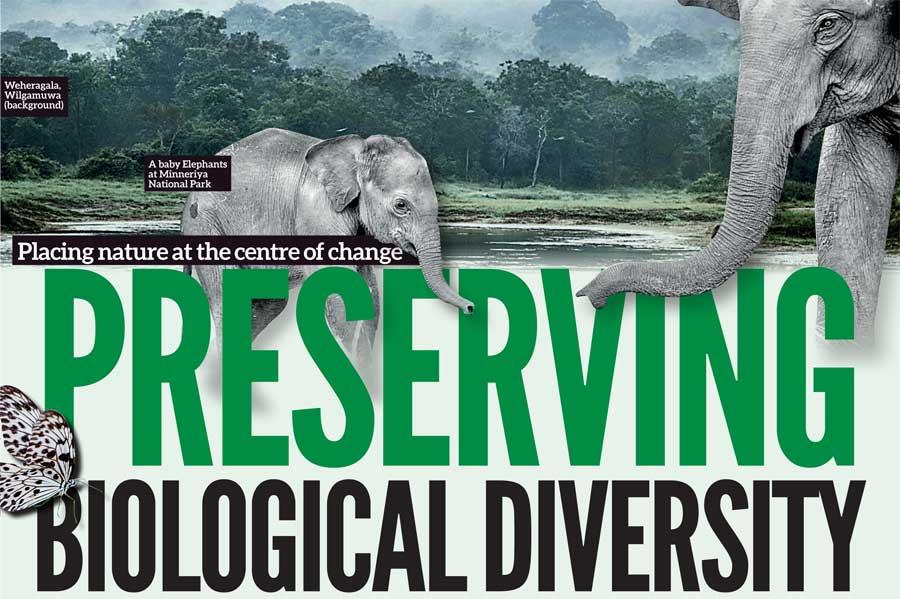06 Jul 2020 - {{hitsCtrl.values.hits}}

COVID-19 pandemic is clear example of how negative human impacts on natural ecosystems can result in widespread consequences
The loss of biodiversity is a loss for humanity. When we re-examine our relationship to the natural world, we find that despite technological advances, we are completely dependent on healthy and vibrant ecosystems for day to day needs.
The International Biological Diversity Day was marked on 22 May, under the timely theme; Our solutions are in nature, bringing home the importance of living in harmony with nature. 
Despite the challenges of the pandemic, 2020 is a year for opportunity and solutions; to adapt and adopt a framework to bend the curve on biodiversity loss. Nature-based solutions that incorporate nature and climate in recovery strategies, safeguarding biodiversity, needs to be made a focal point moving forward. People at all levels need to work together to build a brighter future; failure to act is failing humanity.
Nature and its contributions are essential for human existence and good quality of life: it sustains the quality of air, freshwater and soils, distributes fresh water, regulates the climate and reduces the impact of natural hazards.
Biological diversity, an inherent part of nature, includes not only a wide variety of plants, animals and microorganisms but also the genetic differences within species, between species and ecosystems. Civilizations are built on biological diversity resources- making nature critical to our survival. But nature is under an increasing amount of stress.
“Biodiversity loss is a direct result of our short-sighted human activities including uncontrolled mining and infrastructure development, unsustainable farming and deforestation. All these have degraded ecosystems and have created the conditions that lead to events like possibly the pandemic,” said Elizabeth Maruma Mrema, Acting Executive Secretary of the Convention on Biological Diversity (CBD). “Urgent concerted and collaborative action is needed to build a resilient and sustainable global economy that incorporates nature at its heart,” she added.
According to the 2019 Global Assessment Report on Biodiversity and Ecosystem Service (IPBES), ‘biodiversity is declining faster than at any time in human history’. Around 1 million animal and plant species are threatened with extinction. Human action threatens more species with global extinction now than ever before. Human activity has altered close to 75 per cent of the earth’s surface, 66 per cent of the ocean area is increasingly impacted and over 85 per cent of wetlands have been lost. Global food security is undermined with the disappearing local varieties and breeds of domesticated plants and animals.
"Final key recommendations made by the National Report include: synergy between agencies, stimulating youth involvement, safeguarding biodiversity outside protected areas and the systematic intervention to link and expand the protected area clusters."
If action isn’t taken to reduce the power of drivers of biodiversity loss, the rate of species extinction will further accelerate. Land-use changes, climate change, pollution, natural resource use and exploitation and invasive species are examples of direct drivers impacting biodiversity and ecosystem change. Climate change is identified as a driver that exacerbates the impact of other drivers, of which the impact is seen in different ecosystems such as coral reefs, Arctic systems and savannas. The report found that the current negative trends in biodiversity and ecosystems will not only undermine the progress of the Sustainable Development Goals but will also prevent the achieving of the global goals to conserve and sustainably use nature.
Biodiversity, landscapes and seascapes play an integral role in ensuring ecological resilience and the resilience of ecosystem functions.
As losses mount, the overall system can be compromised- creating new opportunities for diseases and poor health. The loss of biodiversity has been proven to expand zoonoses- diseases transmitted from animals to humans.
In contrast, healthy biodiversity offers excellent protection against pandemics such as the coronavirus. The COVID-19 pandemic is a clear example of how negative human impacts on natural ecosystems can result in widespread consequences.
The UNEP revealed, “Ecosystem integrity underlines human health and development. Human-induced environmental changes modify wildlife population structure and reduce biodiversity, resulting in new environmental conditions. It’s impossible to predict where the next outbreak will come from or when it will be. Growing evidence suggests that outbreaks of epidemic diseases may become more frequent as the climate continues to change.”
Sri Lanka is an island nation with high biological diversity and high endemism. But despite boasting such rich diversity, the country’s unique biological diversity is facing general decline. Hotspots are areas that have a high concentration of endemic species and experiencing exceptional loss and Sri Lanka is listed as one of 36 global hotspots in the world- meaning that a high proportion of the existing species are threatened with extinction, especially those endemic to the country. Sectors such as fisheries, agriculture and tourism depend considerably on biodiversity, deriving critical sources of revenue from it. To better understand the current situation in the country, Daily Mirror interviewed Environmental Foundation Ltd (EFL), Senior Science Officer, Zaineb Akbarally.
There is an array of factors threatening our biodiversity: the most significant is, habitat fragmentation and loss of physiochemical characteristics of ecosystems, river diversions, pollution from both organic and inorganic waste, the spread of invasive species and climate change.
These threats require urgent intervention to prevent the irreversible loss of biodiversity. She noted that it’s a combination of having high diversity and endemism, coupled with extensive loss and degradation of ecosystems that has paved the way for Sri Lanka’s recognition as a hotspot. “A lot of the endemic biodiversity found in Sri Lanka is found to be concentrated in the south-western quarter of the island in the lowland rainforests and central highlands. However, this part of the island also has the least amount of protection and the highest population density, thus demonstrating the vulnerability of our most unique biodiversity,” she said.
She revealed that the team drafting the 6th National Report (detailing the current status of biodiversity in the country) to the CBD had conducted a detailed assessment of the National Biodiversity Strategy and Action Plan (NBSAP) at local, regional and national levels.
“As of 2018, these consultations determined that while certain activities are done well, many other areas need considerable effort if we are to ensure sustainable use of biodiversity. Some of the noticeable signs of progress made included the arrangements that have been put in place for the prevention and eradication of invasive alien species and the ex-situ conservation of genetic diversity of crops which have the potential for economic, food or medicinal uses.”
Final key recommendations made by the National Report include: synergy between agencies, stimulating youth involvement, safeguarding biodiversity outside protected areas and the systematic intervention to link and expand the protected area clusters.
Akbarally identified the lack of synergy between local agencies as an overarching issue. She stressed on the need to facilitate discussions that will engage development practitioners and conservationists. “The disconnect and mistrust between these groups can and has led to terrible environmental consequences. It’s also necessary to create an apex body that has the power to coordinate the activities of various government departments, vested with the responsibility of safeguarding the environment, like wildlife, forest, biodiversity and marine environments have never been under one agency.”
“Education remains a crucial area – only through awareness and education are we going to address many of the threats facing the environment,” she said. When preparing the National Report, workshops were conducted at universities, national youth gatherings and youth environmental groups as a means of engaging and investing in the youth, to educate them on the importance of biodiversity and its value. “These sessions were incredibly insightful and highlighted the interest amongst youth to engage in sustainability and biodiversity conservation. However, more significant efforts need to be made at a national level to tap into this youthful energy and transcend it into action.”
An international treaty, with nearly universal membership, the CBD covers the conservation of biodiversity, sustainable use of its components and the equitable sharing of benefits derived from genetic resources. The Strategic Plan for Biodiversity 2011-2020, adopted at the conference of the parties to the Convention, is a UN-wide framework for action that set global goals and targets and a process for national actions and includes requirements of monitoring and reporting. Under this plan, parties were required to formulate an NBSAP, to implement the Strategic Plan at a national level. In compliance, Sri Lanka compiled and submitted
the NBSAP for 2016-2022.
The Fauna and Flora Protection Ordinance, No. 2 of 1937, Intellectual Property Act, No. 36 of 2003, Fisheries and Aquatic Resources, Act No. 2 of 1996, Plant Protection Act No 35 of 1999 is legislation that forms the legal framework for biodiversity protection. The country has also passed several Action Plans, the most recent being The National Policy on Invasive Alien Species (IAS) in 2016. A former attorney and current legal advisor on environmental law to the EFL, Jagath Gunawardana spoke to Daily Mirror on the status of biodiversity from a legal standpoint.
He said that traditional knowledge was an inherent part of Sri Lanka and is closely tied to biodiversity. However, there is no specific law to cover this aspect.
“Due to the nature of traditional knowledge, enacting one law to protect it is insufficient. Instead, we should make use of multiple legal perspectives to form a system that considers our own national needs,” he opined. Commenting on the adequacy and efficacy of the existing legislation, Gunawardana noted that the current legislation is sufficient and includes amendments that have enhanced the protection of biodiversity.
“Our laws are sufficient and we have some of the best laws in the region but implementation is a different question. Our law is enough to implement things beyond the obligations of the CBD but we lack effective mechanisms to implement it. This is where we fall short,” he said, adding that the inadequate staff and facilities at government departments also contribute to being effective. Although plans are drafted and passed, they have not been implemented. Gunawardana pointed out that the National Policy on Alien Invasive Species has been continuously disregarded by certain agencies in the government sector. The sensitivity of the public to these issues have also been lacking. Expressing his concern on the rapid loss of biodiversity in the country, he underscored the need for expeditious action.
Transformative changes across economic, social, political and technological factors are essential in bringing about change. As a country we need to consider national priorities and circumstances, setting goals that translate into national action. There needs to be a clear commitment to ‘building back better’ to ensure the quality of life is preserved.
pix by Zaineb Akbarally
Over 80 per cent of the human diet is provided by plants.
Around 80 per cent of people living in rural areas in developing countries rely on traditional plant-based medicine for healthcare.
Around 60 per cent of all infectious diseases in humans are zoonotic, as are 75 per cent of all emerging infectious diseases (Ebola, bird flu, Middle East respiratory syndrome, Rift Valley fever, Sudden Acute Respiratory Syndrome (SARS) and COVID-19)
Between 2010 and 2015, the world lost 3.3 million hectares of forest areas.
Fish provide 20 per cent of animal protein to about 3 billion people.
2.6 billion people depend directly on agriculture, but 52 per cent of the land used for agriculture is moderately or severely affected by soil degradation.
28 Nov 2024 1 hours ago
28 Nov 2024 1 hours ago
28 Nov 2024 2 hours ago
28 Nov 2024 4 hours ago
28 Nov 2024 6 hours ago